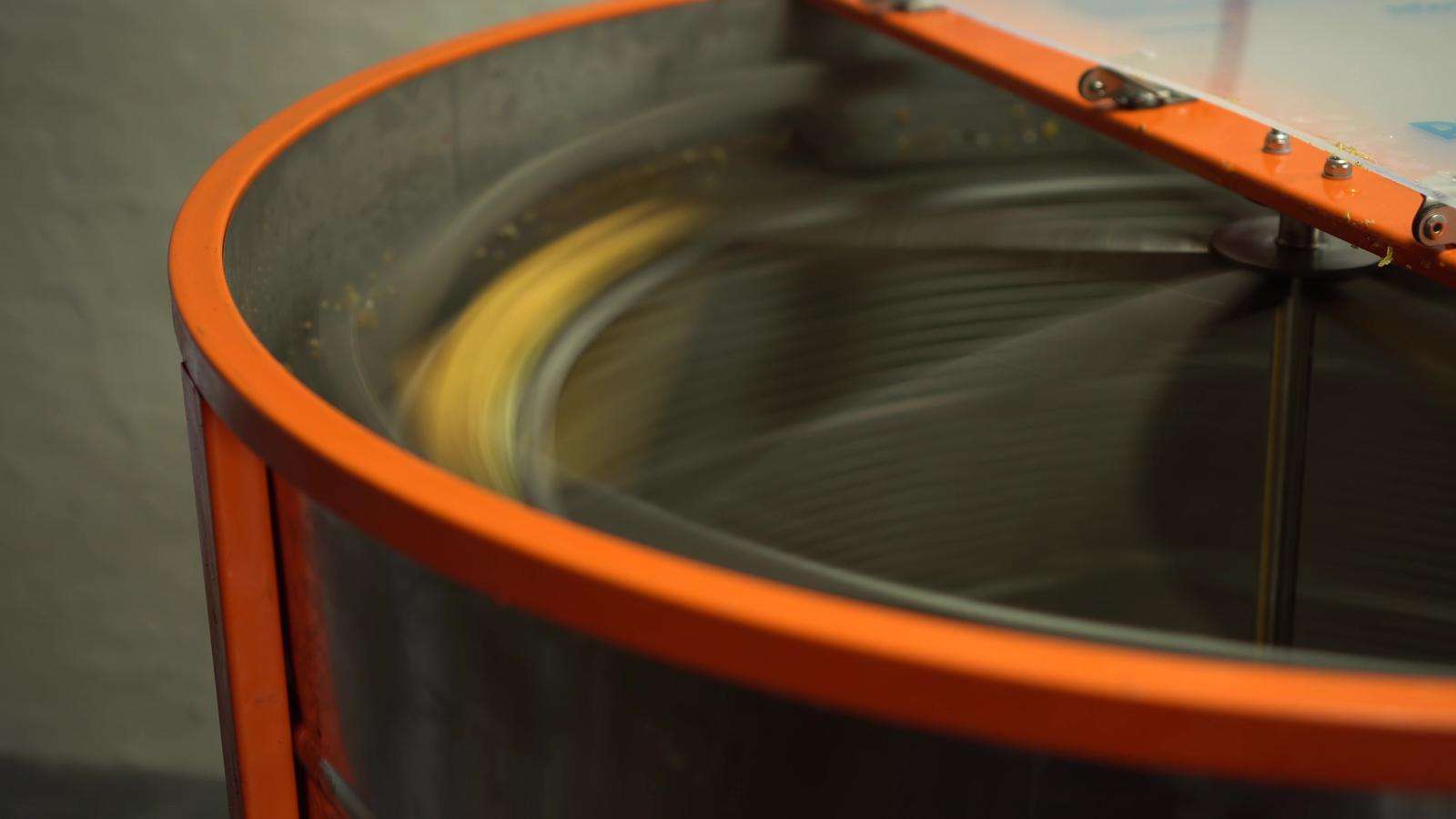Extracting honey from beehives can be a labor-intensive process and back-breaking work. Honey extractors or honey spinners can make this job much easier and more efficient for beekeepers. Which is the best honey extractor option, a radial or tangential honey extractor?
Radial honey extractors are more efficient than tangential extractors. Radial extractors extract honey from both sides of the frame simultaneously and are less likely to damage the honeycomb. Radial extractors come in larger capacity models making them more suitable for larger beekeeping operations.
Honey extractors have made the honey harvesting process easier and more efficient for the beekeeper. Tangential and radial extractors are very similar, but some key differences may sway your choice of one over the other.
Which Honey Extractor Should You Choose: Radial Or Tangential?
The honey harvest is one of the main reasons people get into beekeeping. Although many other products come from the hive, honey is the most well-known.
Extracting honey without a honey extractor is a tedious, time-consuming, and inefficient means of harvesting honey. Honey extractors mechanize the process and offer many other benefits to the beekeepers and the bees.
There are only 2 main types of honey extractors, tangential and radial extractors. How do these honey extractors work, and which would be best for your beekeeping operation?
How Do Honey Extractors Work?
Honey extractors are also known as honey spinners or centrifugal honey extractors, which hints at the method used to extract the honey from the comb.
Radial and tangential extractors use the same principle to extract the honey, but the method is slightly different.
The body of the extractor is a drum, usually made of stainless steel. Inside the drum is a central axis to which a framework is attached to hold the honey-filled frames. This framework is called the basket.
The basket spins around on the central axis, and the centrifugal force generated by the spinning basket flings the honey out of the comb. The honey is splattered onto the inner sides of the drum, where it slowly runs down to the base of the drum.
The inside base of the drum is often conical in shape to allow the honey to run down to the lowest point and make it easier to tap the honey from the drum.
A specially designed tap called a honey gate is installed at the base of the drum. The honey gate can be opened and closed to tap out the honey through filters into smaller containers.
Advantages Of Honey Extractors
Before honey extractors came on the beekeeping scene, the honey was cut out of the frame and sold as comb honey, or the comb was crushed to squeeze out the golden liquid to produce clear raw honey.
The invention of the honey extractor brought several benefits and improvements to the honey harvesting process.
- Faster honey extraction. A honey spinner speeds up the extraction process and allows more frames to be processed.
- Time saver. The faster extraction saves time and allows more frames to be processed in less time. This benefit is extremely useful if you have a lot of beehives.
- The honeycomb is not damaged. The honeycomb remains intact on the frame. Only the caps covering the honey cells are removed before the frames are placed in the extractor.
- Increased honey production. Since the comb remains intact on the frame, the “wet frame” can be placed back in the beehive, ready for the bees to refill it with honey without having to rebuild the comb structure.
These benefits mean that any honey extractor will benefit your extraction, but there are differences between tangential and radial methods that you should know to make the best choice for your beekeeping operation.
Differences Between A Tangential And A Radial Honey Extractor
The tangential and radial extractors use the same centrifugal force principle to spin the honey out of the frames.
The main difference lies in the position of the honey frame in the machine and the efficiency of operation.
How A Tangential Honey Extractor Works
A tangential honey extractor has a basket in the drum, which rotates around the central spindle. The frames are placed in the basket, with one side of the honeycomb facing outwards towards the drum wall and the other side facing inwards towards the central axis.
As the basket is rotated, the centrifugal force generated only extracts honey from the side of the comb facing the drum wall.
When the honey is extracted from one side of the frame, the frame must be flipped over in the extractor, and the frame spun a second time to extract honey from the opposite side.
This extraction method puts a large portion of the centrifugal force directly on the comb, which can cause the comb to disintegrate in the extractor if too much speed is used. The comb is often damaged if no foundation is used in the frame or a wax-only foundation sheet is used.
This creates a higher learning curve to learn the optimal speed for honey extraction without damaging the comb.
Tangential extractors are typically smaller than radial versions since the machine’s design limits the number of frames that can be loaded at one time.
How A Radial Honey Extractor Works
In a radial extractor, the design is more reminiscent of a bicycle wheel with spokes from the wheel’s rim to the central axle.
The honey frame is placed between the spokes, with the top bar of the frame towards the wall of the drum. This design capitalized on the slightly upward-facing structure of a honeycomb cell.
When the frame is placed in the extractor with the top bar facing the drum wall, the cells on both sides of the frame are also directed towards the drum wall due to the slight upward design of the cell.
When the extractor is spun, there is less force exerted on the comb, but the honey is forced out of the cells and onto the drum walls from both sides of the frame simultaneously.
This design makes it unnecessary to flip the frame in the extractor and spin it a second time to complete the extraction. That being said, most beekeepers I know will spin the frame a second time without removing it from the extractor, but reversing the spin direction, to ensure maximum extraction.
Radial extractors are more versatile in design and size. They come in sizes from 2 frame extractors up to 100 frame extractors for large operations.
Radial extractors are generally larger than tangential versions and are more expensive, but they offer a more efficient extraction operation.
Motorized Vs. Manual Honey Extractors
Tangential and radial honey extractors have manual and motorized versions. The motorized versions have electric motors that spin the extractor rather than cranking the machine by hand.
A manual extractor is no problem if you have between 1 and 4 beehives, but you will be getting a fairly intense workout if you have to hand crank a honey extractor for more hives than this.
Motorized extractors can free you up to do other work while waiting for the spin cycle to finish, and you have more control over the machine’s speed.
Motorized extractors are significantly more expensive than manual versions but are necessary when your apiary grows beyond 8 or 10 beehives.
Which Honey Extractor Should You Choose?
Tangential honey extractors are ideal for small-scale beekeepers. They are easier to store due to their smaller physical size and are generally cheaper than radial extractors.
The trend in beekeeping is toward radial extractors because of their higher efficiency. This has resulted in suppliers offering more options in radial extractors than the tangential version. Consequently, tangential extractors are becoming harder to find.
I recommend selecting an appropriately sized radial extractor for your beekeeping operation. If you plan to expand to more than 4 beehives, consider a 10-frame motorized option to cater to expansion in your beekeeping and limit your physical exertion.
Conclusion
Honey extractors are worth their weight in gold for a beekeeper. Owning an extractor will significantly improve your extraction operation and honey production.
The choice of extractor type will largely be driven by your ambitions as a beekeeper and how you intend to grow your apiary, but radial extractors are becoming the popular choice.
References
https://beemaster.com/forum/index.php?topic=49208.0
https://thebeestore.com.au/blogs/bee-blog/which-honey-extractor-is-right-for-you
https://www.beesource.com/threads/radial-vs-tangential-extractors.371666/




